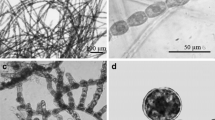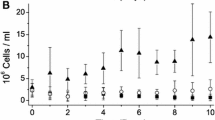Abstract
Gonyaulax polyedra Stein exhibited a combination of photoadaptive strategies of photosynthesis when only a single environmental variable, the light intensity during growth, was altered. Which of several biochemical/physiological adjustments to the light environment were employed depended on the level of growth irradiance. The photoadaptive strategies employed over any small range of light levels appeared to be those best suited for optimizing photosynthetic performance and not photosynthetic capacity. (Photosynthetic performance, P i, is defined as the rate of photosynthesis occurring at the level of growth irradiance.) Among all photosynthetic parameters examined, only photosynthetic performance showed a consistent correspondence to growth rates of G. polyedra. Above 3500 to 4000 μW cm-2, where photosynthetic performance was equal to photosynthetic capacity, cells were not considered light-limited in either photosynthesis or growth. At these higher light levels, photosynthetic perfomance, cell volume, growth rates and respiration rates remained maximal; photosynthetic pigment content varied only slightly, while the photosynthetic capacity of the cells declined. At intermediate light levels (3000 to 1500 μW cm-2), photosynthesis, not growth, was light-limited, and photoadaptive strategies were induced which enhance absorption capabilities and energy transfer efficiencies of chlorophyll a to the reaction centers of G. polyedra. Photosynthetic capacity remained constant at about 280 μmol O2 cm-3 h-1, while photosynthetic performance ranged from 100 to 130 μmol O2 cm-3 h-1. Major increases in photosynthetic pigments, especially peridinin-chlorophyll a-proteins and an unidentified chlorophyll c component, accompanied photoadaptation to low irradiances. Maximal growth rates of 0.3 divisions day-1 were maintained, as were respiration rates of about-80 μmol O2 cm-3 h-1 and cell volumes of about 5.4×10-8 cm-3 cell-1. Below about 1250 μW cm-2, photosynthesis in G. polyedra was so light-limited that photosynthetic performance was unable to support maximal growth rates. Under these conditions, G. polyedra displayed photostress responses rather than photoadaptive strategies. Photostress was manifested as reduced cell volumes, slower growth, and drastic reductions in pigmentation, photosynthetic capacity, and rates of dark respiration.
Similar content being viewed by others
Literature Cited
Brown, T.E. and F.L. Richardson: The effect of growth environment on the physiology of algae: light intensity. J. Phycol. 4, 38–55 (1968)
Delieu, T. and D.A. Walker: An improved cathode for the measurement of photosynthetic oxygen evolution by isolated chloroplasts. New Phytol. 71, 201–225 (1972)
Haxo, F.T., J.H. Kycia, G.F. Somers, A. Bennett and H.W. Siegelman: Peridinin-chlorophyll a-proteins of the dinoflagellate Amphidinium carterae (Plymouth 450). Pl. Physiol., Lancaster 57, 297–303 (1976)
Jeffrey, S.W.: Quantitative thin layer chromatography of chlorophylls and carotenoids from marine algae. Biochim. biophys. Acta 162, 271–285 (1968)
—, M. Sielicki and F.T. Haxo: Chloroplast pigment patterns in dinoflagellates. J. Phycol. 11, 374–384 (1975)
Madelli, E.F.: The effect of growth illumination on the pigmentation of a marine dinoflagellate. J. Phycol. 8, 367–369 (1972)
Frézelin, B.B.: The role of peridinin-chlorophyll a-proteins in the photosynthetic light adaptation of the marine dinoflagellate, Glenodinium sp. Planta 130, 225–233 (1976)
— and R.S. Alberte: Relationships of photosynthetic characteristics and the organization of chlorophyll in marine dinoflagellates. Proc. natn. Acad. Sci. USA 75, 1801–1804 (1978)
— and F.T. Haxo: Purification and characterization of peridinin-chlorophyll a-proteins from the marine dinoflagellates Glenodinium sp. and Gonyaulax polyedra. Planta 128, 133–141 (1976)
—, A.C. Ley and F.T. Haxo: Effect of growth irradiance on the photosynthetic action spectra of the marine dinoflagellate Glenodinium sp. Planta 130, 251–256 (1976)
—, B.W. Meeson and B.M. Sweeney: Characterization of photosynthetic rhythms in marine dinoflagellates. I. Pigmentation, photosynthetic capacity and respiration. Pl. Physiol., Lancaster 60, 384–387 (1977)
Siegelman, H.W., J.H. Kycia and F.T. Haxo: Peridinin-chlorophyll a-proteins of dinoflagellate algae. Brookhaven Symp. Biol. 28, 162–169 (1977)
Song, P.S., P. Koka, B.B. Prézelin and F.T. Haxo: Molecular topology of the photosynthetic light-harvesting pigment complex, peridininchlorophyll a-protein, from marine dinoflagellates. Biochemistry, (Am. chem. Soc.), Easton, Pa. 15, 4422–4427 (1976)
Sorokin, C.: Dry weight, packed cell volume and optical density. In: Hanbook of phycological methods: culture methods and growth measurements, pp 321–344. Ed. by J.R. Stein. New York: Cambridge University Press 1973
Author information
Authors and Affiliations
Additional information
Communicated by O. Kinne, Hamburg
Rights and permissions
About this article
Cite this article
Prézelin, B.B., Sweeney, B.M. Photoadaptation of photosynthesis in Gonyaulax polyedra . Mar. Biol. 48, 27–35 (1978). https://doi.org/10.1007/BF00390528
Accepted:
Issue Date:
DOI: https://doi.org/10.1007/BF00390528




